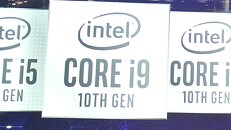Friday, January 10th 2020

Intel's Comet Lake Absence at CES Reportedly Related to Power Consumption Wall
Reports are flooding the web regarding Intel's total lack of reference to their upcoming Comet Lake family of CPUs, which will be branded under the Intel Core 10000 series. As reports would have it, motherboard makers had stock of LGA 1200 motherboards ready to showcase at CES, but were told to pull them in what is equivalent to a logistical "last minute". It seems that both Intel's lack of commitment to Comet Lake on its CES presentation and absence of ecosystem showcase at this year's CES might have something to do with, well, close to shame on Intel's parts.
Comet Lake will increase the maximum core count for their desktop CPUs up to 10 cores and 20 logical threads. But being built on the same 14 nm process as previous Intel generations since Skylake, there isn't much that can be done to offset increased power consumption. This is why industry sources are claiming Intel decided to skip Comet Lake at this CES - a difficulty to rein in the processors' power consumption in time for the event, with power consumption hitting 300 W. And with Intel's Core i9 10900K being configured with a PL2 (Power Level 2) of 250 W, a maximum 300 W under full load seems more than plausible.
Source:
Computerbase.de
Comet Lake will increase the maximum core count for their desktop CPUs up to 10 cores and 20 logical threads. But being built on the same 14 nm process as previous Intel generations since Skylake, there isn't much that can be done to offset increased power consumption. This is why industry sources are claiming Intel decided to skip Comet Lake at this CES - a difficulty to rein in the processors' power consumption in time for the event, with power consumption hitting 300 W. And with Intel's Core i9 10900K being configured with a PL2 (Power Level 2) of 250 W, a maximum 300 W under full load seems more than plausible.

37 Comments on Intel's Comet Lake Absence at CES Reportedly Related to Power Consumption Wall
I only pity those consumers, buying OEM systems with the greatest and latest 10 core CPU from Intel, that will be throttling all the time.
Have you read what you wrote at least once? ;-)That's not power consumption, that's PL2 - peak power consumption for a very short period of time. Power consumption is rumored to be 125W and unlike AMD Intel sticks to what it advertises (unless a motherboard vendor has set the limits differently). I know AMD fans have infiltrated all social media and forums but AMD'ism shouldn't infiltrate your reasoning and sanity.
And while we're at it let me remind everyone that AMD rated the Ryzen 7 3700X CPU 65W while in reality its sustained power draw is 91W. No one bats an eye about this obvious marketing lie.
Edit: made bold the statement about motherboard vendors setting their own limits - people who've replied to this message clearly cannot read.
Both manufacturers have their own definitions and variables but despite some good technical reasoning for how they work with TDP, it is clearly not easily understandable for a normal user.
Anandtech has pretty good articles on what TDP is for both AMD and Intel:
Intel: www.anandtech.com/show/13400/intel-9th-gen-core-i9-9900k-i7-9700k-i5-9600k-review/21
AMD: www.anandtech.com/show/14605/the-and-ryzen-3700x-3900x-review-raising-the-bar/19
Edit:IT would be good to know the methodology of how that is measured. Intel CPUs TDP spec with default values says 125% TDP for 8 seconds. This holds true for non-K CPUs. All bets seem to be off for K CPUs, motherdoards are ignoring spec and impose limits that are far higher than spec or do no impose limits at all. Intel at the same time is the one tolerating these shenanigans.
>>...desktop CPUs up to 10 cores and 20 logical threads ...
Absolutely incorrect "translation" and it should be corrected to:
...desktop CPUs up to 10 cores and 20 logical processors...
or
...desktop CPUs up to 10 cores and 20 hardware threads ...
Definitely outside the efficiency curve :roll:
So is not a valid number, for me at least, for comparision, when actual power ussage is more high than suggested TDP.
There is not a Thermal Watts, or Electrical Watts, just Watts.
Is like say that there are Solid Liters, and Liquid Liters, or a pound of feathers and a pound of rocks etc....
Along with other dubious stuff from motherboard vendors did a while ago. Lots of better sources for this, but this video is easier to understand.
The formula AMD uses to calculate TDP is different.
Both are correct, in their own way...
And then (both AMD and INTEL ) try to say that it's about thermal measure, why they don't just put actual power ussage in the box.
Physical > Logical cores.